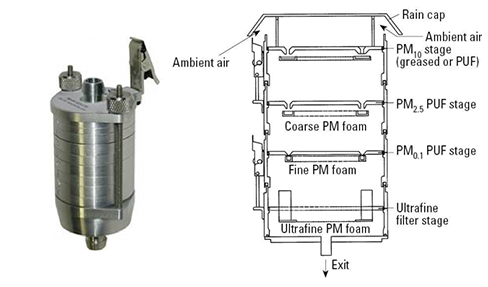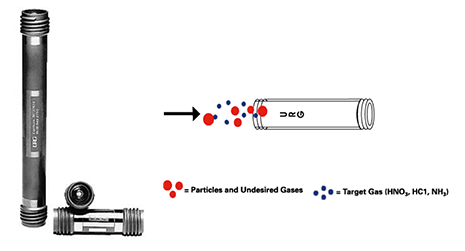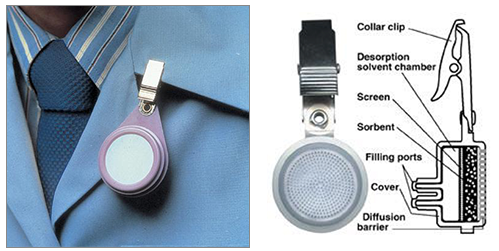Air Monitoring
In order to perform air sampling methods, investigators must consider the phase of the pollutant of interest, the sample type and sample duration. There are two basic categories involved with air sampling: gases/vapors and particulate matter. Highlighted below are some distinguishing properties of the different categories.
Gases & Vapors: Gases occupy the entire space of their enclosure and do not exist in a liquid state at STP. Examples include nitrous oxide, ozone, and carbon monoxide. Vapors are the evaporation products of compounds that may exist in a liquid state at STP. Vapors may condense at high concentrations and coexist in both gas and aerosol forms. Examples include toluene, benzene, and mercury.
Particulate matter (PM): PM refers to either solid particles or liquid droplets suspended in gas. Aerosol refers to the particulate and gas together. Dusts, mists, fumes, smoke, and fibers are all examples of particulate matter. Knowing the chemical composition of particulate matter is crucial in order to understand the possible health effects. The size of PM also determines the extent of exposure since the smallest particles can actually reach the bloodstream while larger particles cannot get past the upper airway.


Basic Calculations for Air Monitoring
- Calculating Concentration: Measurements for particulate matter, gases, and vapors are often expressed as the mass of contaminant per cubic meter of air, μg/m3 or mg/m3. Consider the following example. An IH sample for cobalt dust at 2 liters per minute (lpm) for 7 hours and after laboratory analysis finds that 0.11 mg of cobalt has been collected. If we wanted to calculate the average concentration of cobalt dust in the air during the 7 hours, we would use the following equation:
- Step 1:
- Step 2:
- Step 1:
- Converting mg/m3 to ppm: When measuring vapors or gases, measurements can be expressed as mg/m3 or parts per million (ppm) or parts per billion (ppb). Below is the formula to convert mg/m3 to ppm. MW stands for molecular weight of the agent. This formula can be used when measurements are taken at 25° C and 1 atmosphere.
- Time-Weighted Average: Time-weighted average is generally used in occupational health as a measure of workers daily exposure to a hazardous substance and is averaged to an 8-hour workday, taking into account the average levels of the agent and the time spent in the area. A time-weighted average is equal to the sum of the portion of each time period (as a decimal, such as 0.25 hour) multiplied by the levels of the substance or agent during the time period divided by the hours in the workday (usually 8 hours). Below is the calculation where C1 is the concentration during T1 and Ttotal is total time.
Measuring Air Contaminants
How the pollutant of interest follows along the exposure-disease pathway (from source to health outcome) will greatly influence the sampling method chosen. Resources and feasibility also play an important role. Highlighted below are three broad categories of sampling methods.
- Integrated vs Continuous: With integrated monitoring, the pollutant of interest is extracted from the air and concentrated on a filter, a solid adsorbent, or by reaction with a solution or reagent. Continuous monitoring involves collecting pollutant concentrations continuously over a period of time.
- Active vs Passive: Active sampling requires the use of a pumping device to actively pass air through an air sample container whereas passive sampling does not. Passive sampling relies on the kinetic energy of gas molecules and diffusion of the gases in an enclosed space onto a sorbent medium.
- Personal vs Area: Area monitoring is the use of air monitoring equipment at given locations which is used to represent individual exposure for a population. Personal monitoring occurs when monitoring equipment is placed on an individual to estimate each individual's exposure to a given agent.
The duration of sampling may depend on several factors including study feasibility and the nature of the contaminant source. Investigators must strike a balance between the need to collect samples that are reasonably representative of the desired exposure and the constraints resulting from limited finances and resources.
With a relatively constant source, the assumption is that the emission rate and ultimate concentration does not fluctuate. This generally allows for sampling durations of shorter duration thus a shorter duration time (i.e., several hours of sampling) would be representative of a 24-hour period.
With sources that result in more variation (e.g. emissions from an industrial plant tend to vary depending on hours of operation), longer durations of sampling may be necessary to capture more representative data. Sampling durations can include the use of minimum and maximum sampling volumes, minutes, hours, work-shifts, representative timeframes, and 24 hours.
Resources for sampling and analytical methods
- NIOSH Manual of Sampling and Analytical Methods
- OSHA Sampling and Analytical Methods
- EPA Environmental Test Methods and Guidelines
- SKC Inc, supplier of air monitoring supplies
The following table provides examples of the different types of sampling equipment that can be used to collect air monitoring data. Note this is not a comprehensive list of air sampling equipment and is designed to provide an overview of some of the mechanisms behind air sampling equipment and how they collect air samples.
Active Sampling of PM
There are several methods available for actively sampling particulate matter. Size-selective sampling is the collection of one particle size fraction, such as the collection of PM10 or PM2.5. If the objective is to obtain data regarding a particular PM size, cyclones and single stage impactors can be used to remove large particles from the sample followed by a filter for aerosol collection. Size-segregated sampling refers to the physical separation of airborne particles into several size fractions, which can be achieved with the use of cascade impactors (right) and virtual impactors.
Shown in the image below is a cascade impactor with its schematic illustrating how it collects particles of different sizes on separate plates.

Active Sampling of Gases/Vapors
A sampling pump is required to actively sample gases and vapors. One method involves the use of sorbent tubes, which contain collection materials such as activated charcoal, silica gel, tenex, etc.
Another method involves the use of annular denuders shown below in which the agent of interest is adsorbed onto the wall coated with suitable collection material. The particles and undesired gases will pass through while the target gases will removed adsorbed onto the wall. While this method still requires a pump, it also relies on diffusion to collect the gas or vapors.

Passive Sampling of Gases/Vapors
Passive sampling does not require a pump. Passive samplers have been developed for many gaseous pollutants, such as NO2, O3, and VOCs. The sampling rate is controlled by a physical process, such as diffusion through a static air layer or permeation through a membrane. It's important to note that factors such as temperature, high humidity, and face velocity can affect the sampling process.
Shown below is a vapor diffusion badge that can be used to passively sample vapors. It's relatively easy to use and there are many types (contaminant-specific) available.

Practical Application
Surrounding Greenness and Exposure to Air Pollution During Pregnancy: An Analysis of Personal Monitoring Data is an article by Dadvand et al that investigates the relationship between surrounding greenness and personal exposure to air pollution among pregnant women. Note in this study, the health outcome investigators set to evaluate is reduced disease or a protective effect. Review the introduction and study methods prior to answering the questions below.

